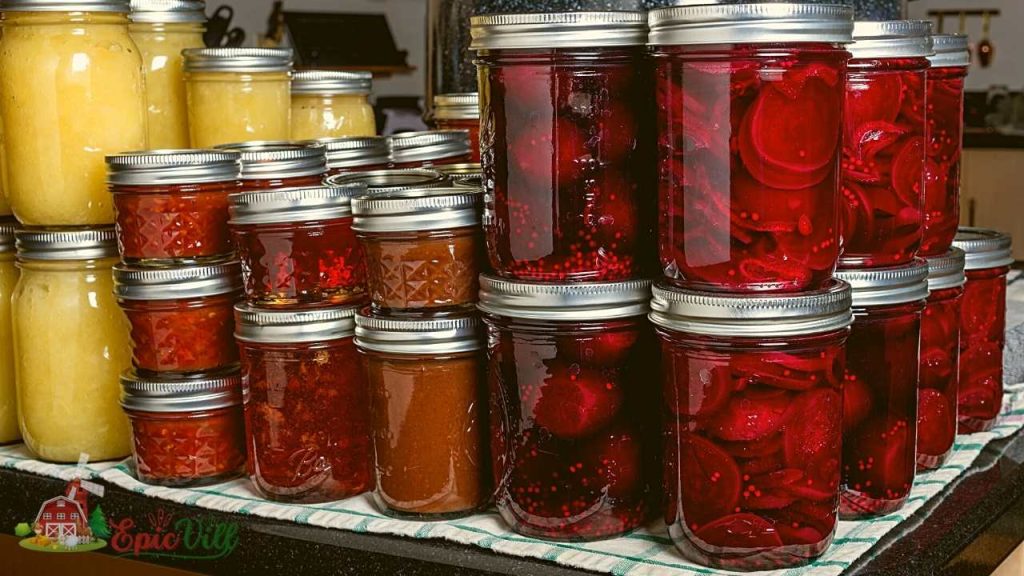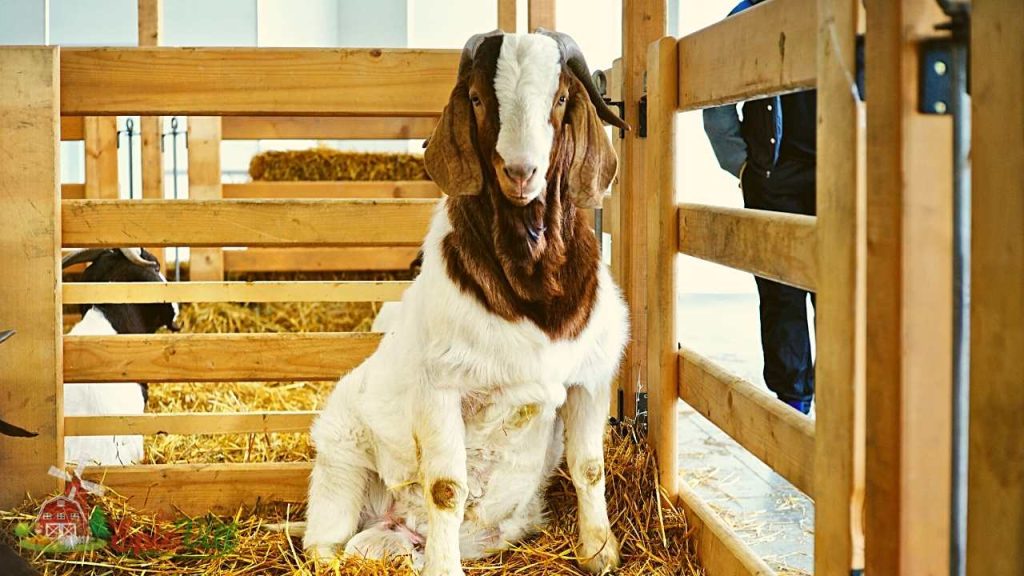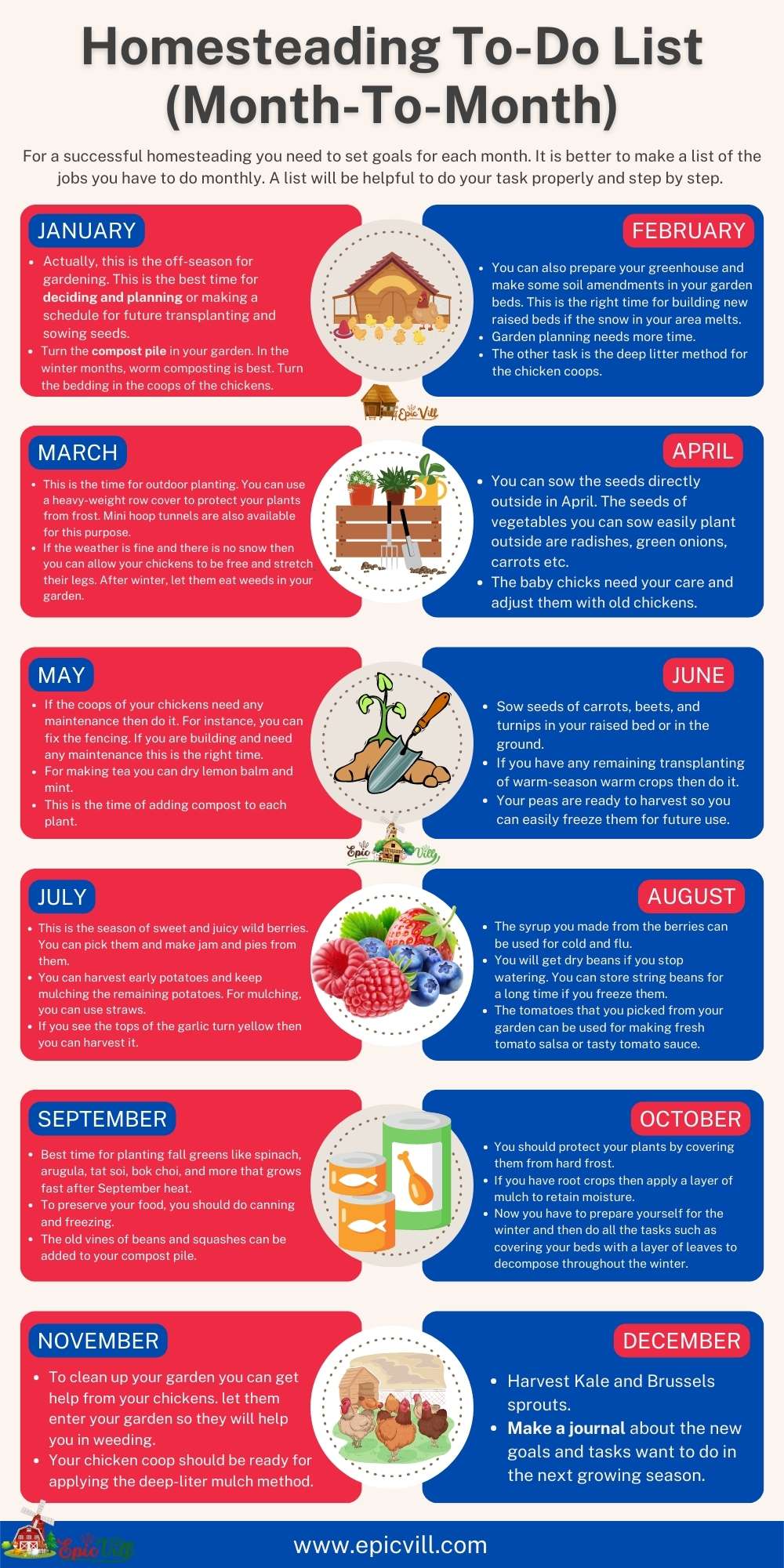Human beings depend on water, sunlight, and soil for growing food to survive in this world. If you talk about our ancestors, they grow their own food on their land and raise useful animals to get milk, eggs, and meat from them.
They worked on their land to stay alive and get food for themselves. As the world progressed and expanded then most people had abundant farm life and chose to live comfortably in urban areas.

Now people like to buy food and other items easily from the market rather than doing hard labor in the fields to grow food. But many people still prefer to be self-sufficient in their needs.
A homestead is a place where a family could live and grow their own food and raise animals. Homesteading is different for every homesteader.
Some like to grow a garden and plant vegetables and fruits for their daily use but some want to become self-sufficient and also grow livestock and establish a kitchen garden also.
After establishing a homesteading, you need to make a list of to-do things monthly.
Common Homesteading Activities

The common home studying activities are mainly four. This will give you an idea that if you have space then what can you do on it?
These are common practices that homesteaders like to do worldwide. You can choose one and become a successful homesteader.
Growing Your Own Food
Many like to grow fresh food supplies for their kitchen. Growing their own food is the foundation of modern homesteading.
You grow anything that you want and like and preserve them for future use. Spend your few hours daily and get fresh vegetables for your daily life.
Raising Livestock
Raising livestock is different from growing plants. The most common animal in your homestead is chicken, you can easily raise chickens and get their eggs and meat.
You can also grow ducks, goats, rabbits, sheep, honey bees, and even cows. All of these animals provide you with something such as egg, milk, meat, and honey. You can also earn a profit by selling these products.
Monthly Task For Homesteading

For a successful homesteading you need to set goals for each month. It is better to make a list of the jobs you have to do monthly. A list will be helpful to do your task properly and step by step.
After making the list of goals the next step is realizing your budget. You should live in reality and do such tasks which do not affect your pocket. For instance, You should buy those animals that are in your budget range.
Chicken, ducks, and rabbits are cheap animals and don’t need separate rooms. They can easily live in coops and hutches. But if you want to raise goats or cows they need proper space.
Following are the tasks and goals to perform monthly to maintain your homestead property. In this article, we only talk about chickens because commonly they are added to every homestead.
JANUARY
January is when you have to think about what plants you want to grow in spring on your homesteading. After deciding on the plants that you can easily maintain, the next step is to check what improvements you want in your garden.
Actually, this is the off-season for gardening. This is the best time for deciding and planning or making a schedule for future transplanting and sowing seeds.
But some tasks regarding gardening can also be performed if you are willing to. For instance, growing spinach, sprouts, and microgreens indoors.
Turn the compost pile in your garden. In the winter months, worm composting is best. Turn the bedding in the coops of the chickens. The food you have preserved in the last season now is the time to enjoy it.
FEBRUARY
- This is the best time to start planning for your garden. In January, you have decided what plants to grow in your garden. Now you can also start seeds indoors in February depending upon the climate in which you are living. You can easily sow the seeds of onions, leeks, celery, and other herbs.
- You can also prepare your greenhouse and make some soil amendments in your garden beds. This is the right time for building new raised beds if the snow in your area melts.
- Garden planning needs more time.
- The other task is the deep litter method for the chicken coops.
- You can also grow some plants even in winter if you try indoor kitchen herb kits.
Keep Reading: Common Seed Starting Mistakes To Avoid
MARCH
- This is the time for outdoor planting. You can use a heavy-weight row cover to protect your plants from frost. Mini hoop tunnels are also available for this purpose.
- This is the right time of transplanting peas and brassicas.
- You can sow the seed of tomatoes, eggplant cabbage, peppers, broccoli, kohlrabi, lettuce, green onions, and cauliflower in March.
- If you did not build new garden beds in February, you can create them now.
- If the weather is fine and there is no snow then you can allow your chickens to be free and stretch their legs. After winter, let them eat weeds in your garden.
- You can buy more baby chicks for this year. Clean out the coops and they need fresh new bedding this month.
- Increase your knowledge by reading more gardening books. Keep an eye on the new transplant so they can easily adjust to a new environment.
Keep Reading: 20 Gardening Hacks You Need To Know Now
APRIL
- You can sow the seeds directly outside in April. The seeds of vegetables you can sow easily plant outside are radishes, green onions, carrots, lettuce, arugula, spinach, beets, turnips, swiss chard, mustard green, and bok choi.
- Plant such as broccoli, kale, cilantro, and chard can be transplanted. You can plant potatoes.
- The baby chicks need your care and adjust them with old chickens.
- If you start the seeds of tomato, basil, and pepper then this is the right time to transplant them outside.
- Some plants need trellises so you should install or build them. It is suggested to join up these trellises. fences to run your plants.
- Apply more mulch to your garden beds.
- It is better to eat wild-free food. For this purpose, you have to grow dandelion greens, wild nettles, dandelion flowers, and dandelion roots.
MAY
- This is for indoor planting of pumpkins, squash, melon, and basil.
- Directly sow the seeds of rutabagas and parsnips as a fall crop.
- If the coops of your chickens need any maintenance then do it. For instance, you can fix the fencing. If you are building and need any maintenance this is the right time.
- For making tea you can dry lemon balm and mint.
- This is the time of adding compost to each plant.
- If you have any remaining brassica then transplant it into the garden.
- Early spring crops can be harvested at this time.
Keep Reading
- Best Animals For Small Homesteads
- Ultimate List Of Homesteading Skills
- Getting Ready For Winter For Homestead
JUNE
- Sow seeds of carrots, beets, and turnips in your raised bed or in the ground.
- If you have any remaining transplanting of warm-season warm crops then do it.
- Your peas are ready to harvest so you can easily freeze them for future use. It is suggested that you harvest peas every couple of days because peas are likely to grow in the cold season so you should pull up vines.
- If you see any flowers in your basil plants then it is suggested that you should pinch them off because it will increase the yield of your crop. At this time, cilantro will have bolted so you should pull them off and grow something else like green onions.
- You should apply earlier mulch for your potato plants. This will help to retain the moisture in the soil.
- If you have any bitter bolted greens or peas vines then you should add them to the compost pile of your garden. You can also give them to your chickens.
- To control the pests you should keep an eye on your plants.
JULY
- You can sow the seeds of lettuce, turnips, cauliflower, cabbage, and broccoli directly into your raised beds or garden beds.
- This is the season of sweet and juicy wild berries. You can pick them and make jam and pies from them. If you want to store them for a long time then freeze them. Dehydrated leaves of raspberries can be used for making tea.
- If you have planted other fruits, you can make jam from them like mangoes.
- You can harvest early potatoes and keep mulching the remaining potatoes. For mulching, you can use straws.
- If you see the tops of the garlic turn yellow then you can harvest it.
- For creating heat stress in the tomato and paper plants. You should reduce watering to encourage fruit ripening.
AUGUST
- Now you can directly sow the seeds or transplant your fall and winter crops such as radishes, lettuce, sweet chard, and kale.
- Best time for freezing basil and other herbs into cubes.
- You will get dry beans if you stop watering. You can store string beans for a long time if you freeze them.
- You should reduce watering for your squash plants to protect them from powdery mildew.
- The syrup you made from the berries can be used for cold and flu.
- Many vegetables such as squash, garlic, and onions are ready to harvest.
- The tomatoes that you picked from your garden can be used for making fresh tomato salsa or tasty tomato sauce.
SEPTEMBER
- Best time for planting fall greens like spinach, arugula, tat soi, bok choi, and more that grows fast after September heat.
- Squash, tomatoes, peppers, winter squash, and frost-sensitive vegetables are ready to harvest. You should cover all the green with a row cover to protect them from hard frost threats.
- To preserve your food, you should do canning and freezing.
- The old vines of beans and squashes can be added to your compost pile.
- Weeds are not good for your plants as they are nutrient stealers so keep removing them.
OCTOBER
- You should protect your plants by covering them from hard frost.
- If you have root crops then apply a layer of mulch to retain moisture. After harvesting, you can store them
- Now you can grow garlic so prepare your beds. It is better to apply a layer of mulch on your garlic beds. Leaves can be used for mulching.
- Turnips and rutabagas are ready for harvest.
- Now you have to prepare yourself for the winter and then do all the tasks such as covering your beds with a layer of leaves to decompose throughout the winter and adding all the nutrients to the soil before the snow arrives.
NOVEMBER
- This is the time to enjoy your labor and eat your favorite fruits which you have grown in your garden.
- It is better to make a garden general about what you have done for growing your favorite veggies and fruits in your garden. This will help you to improve yourself and try new things.
- To clean up your garden you can get help from your chickens. let them enter your garden so they will help you in weeding.
- Your chicken coop should be ready for applying the deep-liter mulch method. The water for your chickens will not freeze if you add a heated chicken waterer.
DECEMBER
- You should harvest Kale and Brussels sprouts before snow starts.
- December is the time to relax with your family because you have to do less work on your homestead.
- The harvest you have preserved for winter use can be used at this time.
- Make a journal about the new goals and tasks want to do in the next growing season.
You can add more tasks and goals to this monthly to-do list according to the animals and plants you have on your homestead.
